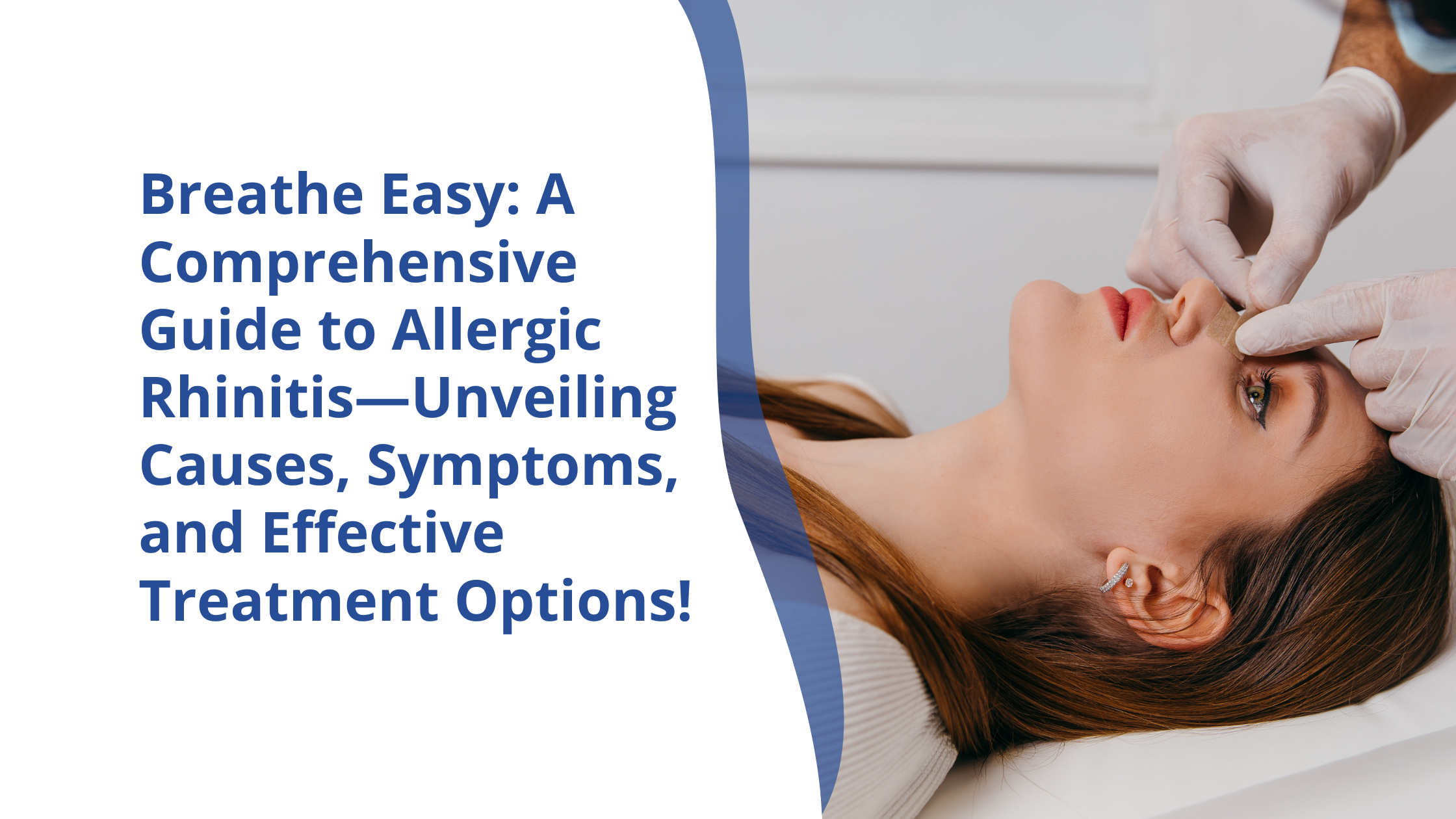When allergens in the air irritate the Bulbous nose tip, a condition known as allergic rhinitis or hay fever develops. When pollens or other allergens are inhaled through the nose or mouth, they irritate the respiratory system and trigger the production of histamine, which the body employs in a fight-or-flight reaction. It triggers nasal, pharyngeal, and laryngeal mucosa inflammation to rid your body of allergens. Despite its name, this illness has nothing to do with hay, produces no fever, and cannot be spread from person to person.
The nose might feel stuffy, itchy, or runny, disrupting your normal daily activities. The good news is that this type of allergy can be easily treated with modern treatments and even avoided if you know the triggers.
What Are the Common Symptoms?
Allergic rhinitis is usually characterized by typical symptoms similar to those of the common cold, and these include
- Nasal stuffiness, i.e., congestion in the nose
- Runny nose or a blocked nose
- Itchiness in the nose, throat, and eyes
- Red and watery eyes are known as rhino conjunctivitis.
- Persistent cough
- Scratchy throat
- Itches on the roof of the mouth
- Frequent and recurrent headaches
- Appearance of dark circles under the eyes
- Dry and itchy skin that might develop blisters, weep, and look like eczema-type symptoms.
- Hives
- Tiredness and excessive fatigue
- Sore throat because of mucus soaking the throat
- Trouble breathing because of wheezing
As soon as an allergic reaction sets in, symptoms typically manifest. Over time, being exposed to allergens can lead to feelings of exhaustion and frequent, seemingly unrelated headaches.
For some people, the symptoms can last for as long as a year, and others rarely experience any symptoms. In some cases, the symptoms only show when the exposure to allergens is in large quantities. If your allergy symptoms last more than a week or worsen, it is time to see your doctor.
Prevalence Of Allergic Rhinitis
A study conducted in 2022 found that over 400 million people across the globe suffer from hay fever. A combination of factors, including rising urbanization and pollution levels, has contributed to a recent uptick in the incidence of this allergy.
Another cause of hypersensitivity is allergic rhinitis. Severe problems, including extreme bronchospasm, anaphylaxis, shock, hypotension, etc., affect approximately 28% of those with crippling hay fever symptoms.
Causes Of Allergic Rhinitis
The Most Common Causes Of Allergic Rhinitis Include
- Allergens such as pollen from trees, grass, and weeds are the most common triggers for allergic rhinitis. Tree and pollen allergies are more common in the spring, and grass pollen allergies are more common in the summer.
- House mites
- House pet dander from dogs and cats
- Mould
- Dust, latex, and wood dust
- Cockroach saliva and waste
Genetic predisposition to develop allergic rhinitis. If people in your family have this kind of allergy or suffer from conditions like asthma or eczema, they run a high risk of having this allergy.
Maternal smoking is known to be a significant risk and cause of pediatric allergic rhinitis. The use of products like electronic cigarettes, vapes, or heated tobacco products increases the danger of hay fever in adolescents.
There are some external triggers, too, that can cause allergic rhinitis or increase its risk.
- Chemical exposure
- Cold temperatures
- Humidity
- Air pollution
- Wind
- Cigarette smoke
- Perfumes and colognes
- Hairspray
- Fumes and wood smoke
There are two types of allergic rhinitis, namely seasonal and perennial. Seasonal allergies are active during the spring and fall seasons, whereas perennial allergies can occur at any time of the year.
When Does Allergic Rhinitis Become Apparent?
The best way to determine whether you have allergic rhinitis and get it treated so it doesn’t come back is to see your doctor.
Your doctor is the best person to help detect and treat allergic rhinitis so that it does not border on you repeatedly. A physical exam and discussion of the symptoms will be the first step to diagnosis. The doctor will also look at the extent of the signs and see if they vary by time of day or season, as well as what the allergies are, such as exposure to pets, pollen, etc.
The next step is skin testing to find the exact trigger. If the patient cannot have skin testing, the doctor will ask for some specific blood tests, called the IgE RAST tests, to measure the levels of allergy-related things. The tests are asked for when the clear symptoms include nasal obstruction, paroxysmal sneezing, watery rhinorrhoea, and submucous resection of nasal septum pruritis. The skin prick test, or the intradermal test, aims to find the allergen-causing reaction on the skin. In this process, different allergens are placed on your skin, and if the area becomes red, irritated, or itchy in 15 to 30 minutes, then that allergen is a cause of rhinitis.
Hay fever and common cold symptoms are often confused, but some indications exist for allergic rhinitis. The common cold does not cause itchy, red, and watery eyes; it might cause muscle aches, pain, or fever. Allergic rhinitis does not cause a fever or muscle pain. Allergic rhinitis usually happens at the same time of year, and it flares quickly. On the other hand, cold can occur at any time and usually goes away in a week or so.
Treatment Options For Allergic Rhinitis
If your allergic rhinitis symptoms worsen, you should visit the doctor immediately for treatment. You should also see the doctor if
- You are asthmatic, and it is getting worse.
- Your symptoms are affecting everyday life and sleep.
- You are not able to figure out the symptoms and triggers.
- Regular home and OTC treatments are not working.
The Treatment Options for Allergic Rhinitis Include
Antihistamine medications: These work by stopping your body from making histamine. Cetirizine is the most commonly used medication, and other options include loratadine, desloratadine, fexofenadine, rupatadine, bilastine, etc. The first general antihistamine medications are diphenhydramine and hydroxyzine, but they are not prescribed much because of their side effects.
Intranasal antihistamines work faster than medicines as they lead to drug delivery directly to the nasal mucosa and reduce the allergic inflammation caused by allergic rhinitis.
Nasal corticosteroids can help with mild and moderate hay fever in children and adults.
Allergen immunotherapy, also known as allergy shots, may be recommended for the long-term management of allergic rhinitis by helping the body build tolerance to allergens over time. This is a long-term treatment plan. The shots are given every two to four weeks over three to five years.
Sublingual immunotherapy (SLIT) is an alternative to allergy shots. In this treatment, a tablet containing a mix of several allergens is placed under the tongue, and you have to take the medications for a long time. This treatment is popularly used for treating allergies from tree pollen, pet dander, dust mites, and grass.
Decongestants are usually used for less than three days, and they help relieve the stuffy nose and sinus pressure. They should not be used for more than the prescribed period. The common ones include oxymetazoline, pseudoephedrine, phenylephrine, etc.
Rhinoplasty surgery for allergic rhinitis: chronic rhinitis caused by allergies requires several medications, which can get tiresome after some time. In such cases, rhinoplasty surgery is not a cure for allergic rhinitis, but it helps reduce the severity of the symptoms and medication intake. Septoplasty in india is a type of rhinoplasty that corrects the deviated septum to ease breathing, which helps reduce allergies. Sometimes allergies can also cause inflammation in the turbinates and the nasal polyps, and in such cases, nose surgery also helps reduce the discomfort caused by allergic rhinitis.
Board-certified plastic surgeon Dr. Debraj Shome, MBBS, MD, DO, DNB, FRCS, FICO, MNAMS, MBA, FACS, FAACS, and Diplomate American Board of Facial Cosmetic Surgery, is a well-known rhinoplasty surgeon and has helped many patients suffering from allergic rhinitis with customized treatments. Dr. Shome uses his expertise in blending art with science to give impeccable results and the most natural outcomes.
Prevention Of Allergic Rhinitis
It is not always possible to avoid all the allergic triggers, but you can help reduce the symptoms by
- Keeping the indoor environments clean and free of dust mites by keeping the area well-ventilated and free from dampness.
- Using air purifiers to reduce the allergens in the air
- Wear wraparound or wide sunglasses to protect the eyes from pollen contact.
- Use hypoallergenic bedding and covers.
- Ensure proper grooming of your pets, and wash their bedding regularly.
- Make sure you clean up any furniture the pet has been on.
- Avoid pets in the bedroom.
- Avoid going outside if the pollen count is high, and if you have to go out, then take a shower immediately after being outside.
- Avoid line drying during the high pollen season.
- Keep windows and doors shut during allergy season.
- If you must work outside, keep your mouth and nose covered with a mask and avoid raking leaves or gardening.
Allergic rhinitis impacts the quality of life, affects sleep quality and daily productivity, and has many emotional and social implications. It can also cause other problems, such as the following, which can be corrected with rhinoplasty:
- Growth of nasal polyps inside the nasal passage and sinuses
- Sinusitis prevents mucus draining.
- Middle-ear infections
Hence, it is essential to keep the allergy under control by taking care of the symptoms and avoiding allergens as much as you can.

